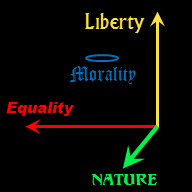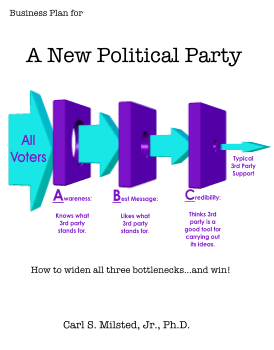The Will of The People
Do winner-take-all elections produce true representation of the people? Consider the following scenario:
Bo, Billy and Bertha are running for city council. The hot issues in the election are whether to crack down on jaywalking and whether the city should finance a monster-truck arena. The positions of the candidates are as follows:
|
|
Crackdown |
Arena Financing |
|
Bo |
Y |
N |
|
Billy |
N |
Y |
|
Bertha |
N |
N |
Bo and Billy are well known figures with connections to the “old boy network” while Bertha is a newcomer to politics motivated by recent abuses of power. Let’s see what some voters think.
Joe has a penchant for jaywalking, and he sees no reason to spend tax money on a monster truck arena. So he prefers Bertha’s program. However, since he is really concerned about Bo’s position on jaywalking, he opts to vote for Billy because he has a better chance of defeating Bo.
Sally hates monster trucks. She thinks monster trucking is a perversion of the true sport of the demolition derby. She also doesn’t see why there is a need for new laws on jaywalking, when the old ones are not being vigorously enforced. So Bertha should be her preferred choice. However, she votes for Bo, since he has a better chance of beating Billy.
For most elections in the United States, the law is not majority rule, but plurality rule. The fact that most elections do end up with a majority comes from the fact that support drops away from outsider candidates because of the “lesser of two evils” line of reasoning, described above. Indeed, it is for this reason that we have two major political parties – when our Founders tried to avoid having any political parties.
One step towards a more democratic republic would be to eliminate plurality rule. As a first step we could require runoff elections between the top two candidates if none get a majority. This is done in some states, and it would solve the dilemma in the race described above. But consider a more wide-open, evenly matched contest:
|
Candidate |
Vote Percentage |
|
Earl |
25 |
|
Debbie |
20 |
|
Ray |
19 |
|
Barbara |
17 |
|
Felicity |
12 |
|
Will |
7 |
|
Total |
100 |
While Earl and Debbie are the top vote getters, their combined vote total is less than a majority. If those who voted for Will, Felicity and Barbara preferred Ray over Earl or Debbie, then Ray would win the run-off. So, we should have at least three candidates in the run-off. (While this may seem a perverse situation, it actually happened in the French presidential elections. Ultra rightwing candidate Jean-Marie LePen came in second in the first round of voting. The result was to have the Socialists backing center-right Jacques Chirac [ http://edition.cnn.com/2002/WORLD/europe/04/22/france.europe/index.html ]).
Having three in the run-off could lead to a second run-off. This does get expensive, but government is expensive. How much is ensuring democracy worth?
But even the above reform is imperfect. What if all those who voted for Will and Felicity preferred Barbara over Ray? Then, shouldn’t Barbara make it into the run-off instead of Ray? Then again, what if all those who voted for Will preferred Felicity?
A better yet approach would be to kick out the votes of the weakest candidate and ask for the next favorite choice of those who voted for that candidate, and then repeat the process until a majority vote is achieved. This could lead to a rather exhausting number of rounds of votes – acceptable at a political conventions, town meetings or the Electoral College, but a bit much for a secret vote from the general public.
Fortunately, we could hold all the rounds at once by having people not simply select their favorite candidate, but to rank the candidates from best to worst. Consider the following ballot:
|
Candidate |
Best |
2nd Best |
3rd Best |
4th Best |
5th Best |
6th Best |
|
Earl |
X |
|
|
|
|
|
|
Debbie |
|
|
X |
|
|
|
|
Ray |
|
|
|
|
|
X |
|
Barbara |
|
|
|
X |
|
|
|
Felicity |
|
|
|
|
X |
|
|
Will |
|
X |
|
|
|
|
If done electronically, the voting machine could guarantee a valid vote for everyone – no more than one selection on any row or column. To guarantee no electronic trickery, the machine could generate a human-readable paper ballot, which would be the official ballot. The voter could verify the selections on her paper ballot and then take the ballot to a counting machine to make sure the machine can read the ballot properly – no more “hanging chad” issues.
With such a ballot, we could eliminate one candidate at a time in a series of virtual run-off elections until a majority winner is determined. In fact, we could do even better with such information.
Consider our original vote total. Suppose Will is the second favorite candidate of those who voted for Ray, Felicity, Barbara and Debbie. Perhaps Will should be the winner. Such a condition could arise in a situation where there are a large number of passionately opposed factions and one moderate candidate. The faction members support their candidate first, but would rather have a conciliatory moderate to a member of one of the other factions. This is a particularly important consideration in certain developing nations where elections can get violent.
A method that would discover this is by Condorcet. In this method, we take the rankings and do pairwise elections between each pair of candidates. If any candidate wins all pairwise comparisons with each of the other candidates, that candidate wins. For example, in the last presidential campaign, a very liberal voter might have filled out the ballot as follows:
|
|
Best |
2nd Best |
3rd Best |
4th Best |
|
Browne |
|
|
X |
|
|
Bush |
|
|
|
X |
|
Gore |
|
X |
|
|
|
Nader |
X |
|
|
|
A pairwise comparison would look like:
|
|
Browne |
Bush |
Gore |
Nader |
|
Browne |
- |
1 |
0 |
0 |
|
Bush |
0 |
- |
0 |
0 |
|
Gore |
1 |
1 |
- |
0 |
|
Nader |
1 |
1 |
1 |
- |
This chart shows that Nader receives one vote against any of the other candidates. Gore gets a vote when paired up with any candidate other than Nader. Browne gets a vote only when paired up against Bush. Such tables would be tabulated for all the ballots (electronically!) to see if any candidate wins all pairwise contests.
Let’s throw in a single conservative voter:
|
|
Best |
2nd Best |
3rd Best |
4th Best |
|
Browne |
|
X |
|
|
|
Bush |
X |
|
|
|
|
Gore |
|
|
X |
|
|
Nader |
|
|
|
X |
This makes our chart:
|
|
Browne |
Bush |
Gore |
Nader |
|
Browne |
- |
1 |
1 |
1 |
|
Bush |
1 |
- |
1 |
1 |
|
Gore |
1 |
1 |
- |
1 |
|
Nader |
1 |
1 |
1 |
- |
Hmmm, we are in a dead even tie. Nader doesn’t spoil Gore and Browne doesn’t spoil Bush.
Throw in a Right-leaning libertarian vote:
|
|
Best |
2nd Best |
3rd Best |
4th Best |
|
Browne |
X |
|
|
|
|
Bush |
|
X |
|
|
|
Gore |
|
|
X |
|
|
Nader |
|
|
|
X |
And toss in a pot-smoking hippie:
|
|
Best |
2nd Best |
3rd Best |
4th Best |
|
Browne |
|
X |
|
|
|
Bush |
|
|
|
X |
|
Gore |
|
|
X |
|
|
Nader |
X |
|
|
|
And we get:
|
|
Browne |
Bush |
Gore |
Nader |
|
Browne |
- |
3 |
3 |
2 |
|
Bush |
1 |
- |
2 |
2 |
|
Gore |
1 |
2 |
- |
2 |
|
Nader |
2 |
2 |
2 |
- |
Finally, toss in a conspiracy theorist:
|
|
Best |
2nd Best |
3rd Best |
4th Best |
|
Browne |
X |
|
|
|
|
Bush |
|
|
|
X |
|
Gore |
|
|
X |
|
|
Nader |
|
X |
|
|
And we get:
|
|
Browne |
Bush |
Gore |
Nader |
|
Browne |
- |
4 |
4 |
3 |
|
Bush |
1 |
- |
2 |
2 |
|
Gore |
1 |
3 |
- |
2 |
|
Nader |
2 |
3 |
3 |
- |
At this point, Browne has beaten everyone in a head-to-head. Bush loses to everyone. Gore beats Bush, but loses to Browne and Nader. Nader beats Bush and Gore, but loses to Browne.
Condorcet’s system eliminates “lesser of two evils” voting. It simulates the “what if” scenario of if only two candidates were on the ballot with each pair of candidates. Alas, Condorcet’s system can end up with a situation were all the candidates are beaten by at least one of the other candidates. So some type of tie-breaking approach is required. See the Further Reading links.
Further Reading:
|
Homework AssignmentConsider the current situation in Iraq. We have multiple factions that have a penchant for persecuting the other factions: Sunnis, Shiites, Kurds, and Christians. Suppose each faction were to run a presidential candidate based on domination for that group, along with a conciliatory moderate promising ethnic fairness and harmony.
|


